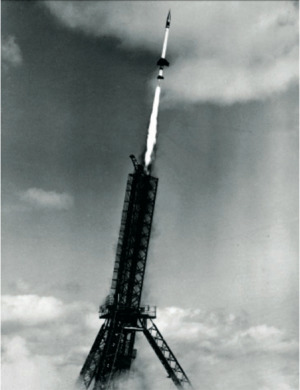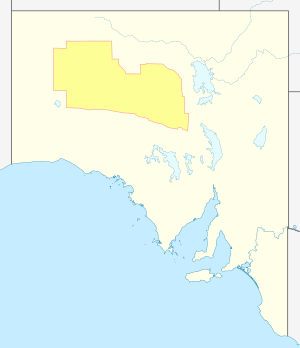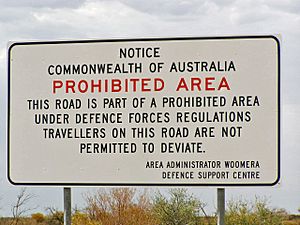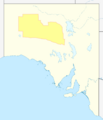RAAF Woomera Range Complex facts for kids
Quick facts for kids RAAF Woomera Range Complex |
|
|---|---|
| near Woomera, South Australia in Australia | |

Launch of a NASA Skylark sounding rocket from the Woomera Range Complex in c. 1961
|
|

Map of South Australia showing the land area covered by the RAAF Woomera Range Complex
|
|
| Coordinates | 30°57′19″S 136°31′56″E / 30.9553°S 136.5322°E |
| Type |
|
| Area | 122,188 km2 (47,177 sq mi) |
| Site information | |
| Owner | Government of South Australia under a crown lease to the Department of Defence |
| Operator | |
| Open to the public |
Prohibited access |
| Status | Active |
| Site history | |
| In use | 1946 – present |
| Test information | |
| Nuclear tests | 9 (See British nuclear tests at Maralinga and Operation Totem) |
| Other tests | Missiles, aircraft weapons, drone aircraft, rockets |
The RAAF Woomera Range Complex (WRC) is a huge area in South Australia. It's used by the military and for space-related activities. It's about 450 kilometers (280 miles) northwest of Adelaide. The Royal Australian Air Force (RAAF) runs the WRC. This is part of the Australian Defence Force (ADF).
The WRC covers a massive 122,188 square kilometers (47,177 square miles). That's about the size of a country like North Korea! The sky above this area is also controlled by the RAAF. This is to keep everyone safe and secure. The WRC is a special place where the ADF tests military equipment.
Over the years, this complex has had different names. It was once called the Anglo-Australian Long Range Weapons Establishment. Then it became the Woomera Rocket Range. In 2013, it was renamed the RAAF Woomera Range Complex (WRC). The land part of the WRC is called the Woomera Prohibited Area (WPA). It's known as the largest land-based test range in the Western world.
Contents
Understanding the Woomera Complex
The name Woomera comes from an Australian Aboriginal word. It's from the Dharug language of the Eora people. A woomera is a wooden tool used to throw spears. This name was chosen for the town of Woomera, also known as Woomera Village.
Different Names Over Time
Since it started in 1947, the Woomera facility has changed names. From 1947 to 1980, it was the Anglo-Australian Long Range Weapons Establishment or the Woomera Rocket Range. During this time, the Australian Government used it for research and testing long-range weapons. Later, it was mostly known as the RAAF Woomera Test Range. In 2013, it became the RAAF Woomera Range Complex (WRC). This change was part of a plan to make it ready for the ADF's future needs.
The Woomera Prohibited Area (WPA)
The WPA is the ground area of the WRC. It includes the Nurrungar Test Area (NTA). This huge area is 122,188 square kilometers (47,177 square miles). It's the biggest land-based test range in the Western world. The WPA is also rich in minerals like iron ore and gold. The government thinks there could be billions of dollars worth of resources there.
To enter the WPA for non-military reasons, you need special permission. This makes sure that Defence activities are not disturbed. The WPA has different zones:
- Green zones: Used infrequently by Defence.
- Amber zones: Used periodically.
- Red zones: Used frequently for testing.
Some public roads and railways pass through the WPA. These include the Stuart Highway and the railway to Darwin. Sometimes, for safety, Defence might close these routes for short periods during tests. The Woomera Prohibited Area Coordination Office (WPACO) manages the daily operations. They work with the Government of South Australia because the land is a mix of government land and areas leased for farming or mining.
Woomera Restricted Airspace (WRX)
The sky above the WPA is called the Woomera Restricted Airspace (WRX). The RAAF controls who can enter this airspace. This is for safety and security during tests. When needed, the RAAF issues a 'Notice to Airmen' (NOTAM). This notice tells pilots that parts of the WRX are closed.
History of the Woomera Complex
The Woomera Prohibited Area was first set up in 1947.
Early Military Use
Anglo-Australian Joint Project
After World War II, the British wanted to test rockets. But their country was too crowded. So, they asked Australia for a large, empty area. In 1946, the two countries started the Anglo-Australian Joint Project. This project was for designing and testing weapons. Australia provided the testing facilities and most of the money. The United Kingdom supplied most of the scientific equipment and people.
At its busiest, the complex was 270,000 square kilometers (104,247 square miles). It was mostly in South Australia. It was later made smaller to 127,000 square kilometers (49,035 square miles). Still, it was the largest land-based weapons test complex in the Western world.
Many weapons were designed and tested here. These included missiles like the Sea Wolf and Rapier. Research rockets like the Black Knight were also tested. Missile testing began in 1949. The Joint Project continued until 1980. In the 1950s and 1960s, Woomera was the second busiest rocket range in the world. Only Cape Canaveral in the US was busier.
When the Joint Project ended in the early 1970s, the town's population dropped. But then, a joint US/ADF facility called Nurrungar opened nearby. This brought more people to the village. In the late 1990s, the ADF realized Woomera was special. It was one of the only places left in the Western world big enough to test new, advanced weapon systems. This made Woomera very important for Australia's future defense.
United States Involvement
In the early 1960s, Woomera helped with the US Mercury and Gemini space programs. Special tracking stations were built nearby. These stations were very important during the first Moon landing mission. One key facility was "Deep Space Station 41" (DSS-41). It helped track spacecraft in the 'race for space'. Most of DSS-41 was taken down in the 1970s.
Australian Defence Force Use
By the 1990s, the RAAF understood Woomera's value. It was the only land-based test range in the Western world large enough for testing new weapons. The RAAF gradually took over running the entire complex. Since 2009, there have been projects to upgrade the range's systems and buildings. These upgrades are to support new aircraft like the F-35 Joint Strike Fighter.
Australia was the fourth nation to launch a satellite from its own land. This was WRESAT in 1967. This happened at a site near Lake Hart. The old rocket launchers there are a reminder of Australia's past in space research. In 2007, Woomera was recognized by the American Institute of Aeronautics and Astronautics (AIAA). It was placed in their hall of fame, alongside famous sites like Kitty Hawk (first flight) and the Moon's Sea of Tranquility (first human Moon landing).
The RAAF Woomera Test Range (WTR) is the main part of the WRC. It's managed by the Air Warfare Centre RAAF. The Woomera Test Range Squadron (WTR SQN) handles daily operations. In 2016, the Australian Government announced a $297 million plan to upgrade Woomera. This will help test advanced systems like those on the F-35 Joint Strike Fighter.
The base was also used for testing the Blue Streak missile system.
Other Military Uses
In 2013, testing began on Taranis. This is a drone aircraft developed by the UK. The complex is used for Australian Defence Force trials. It's also leased to other countries and private companies. They use it to test weapons, rockets, and drone aircraft.
Civil Aerospace Use
Woomera has also been used for rocket launches. In the 1950s, the Black Knight rocket was tested here. Australia's first satellite, WRESAT, was launched from Woomera in 1967. In 1999, the complex was named a National Engineering Landmark.
In 2002, the University of Queensland launched a rocket with a HyShot engine. This was the first successful flight of a hypersonic scramjet engine. During the Cold War, Woomera had the second highest number of rocket launches in the world. Only NASA's Cape Canaveral had more. Between 1957 and 2007, over 518 launches happened at Woomera.
Other notable launches included:
- From 1957 to 1987, 258 Skylark rockets were launched.
- In the 1970s, NASA launched 20 Aerobee rockets for experiments.
- NASA launched its last rocket from Woomera in 1995.
- In 2017, a Sonda rocket was launched for a hypersonic mission.
Woomera has also been a landing site for space probes:
- In 2010 and 2020, Japanese space probes Hayabusa and Hayabusa2 landed in the WPA. They brought back samples from asteroids.
Launch Areas
Many different launch areas have been used at Woomera over the years. Each area was designed for specific types of rockets or tests. Some examples include:
- LA1 - S launch complex
- LA2 - Sounding rocket launch complex (for rockets like Skylark and Jaguar)
- LA5A and LA5B - Black Knight launch complexes
- LA6A - Europa and Blue Streak launch complex
- LA8 - Redstone and Aerobee launch complex
Current Activities and Uses
Baker Observatory
The Woomera Baker Observatory is inside the WPA. It has a public telescope owned by the Defence Department. Volunteers help host stargazing nights for the public and military groups. A new telescope was installed in 2020.
Other Uses of the Area
In 2004, a V8 Supercars racing team was caught doing illegal vehicle testing at Woomera. They were fined for breaking testing rules.
In 2011, the government announced that large parts of the Woomera Prohibited Area would be opened for mining. This was after years of talks about sharing the area. It contains billions of dollars worth of minerals.
Besides Defence, other groups use the area:
- Farmers who lease land for animals.
- Aboriginal people and traditional owners.
- Mining companies (like OZ Minerals) and opal miners.
- Tourists and research groups.
- The rail operator, One Rail Australia.
Mines in the area include the Challenger gold mine and Prominent Hill copper mine.
Managing the Woomera Complex
Land Management
Since 2015, the Air Warfare Centre RAAF (AWC) manages the Woomera Range Complex. The Woomera Test Range Squadron handles daily operations. This squadron is part of the Air Force Ranges Directorate (AFRD). These groups are based in Adelaide, about 450 kilometers (280 miles) south-west of Woomera.
RAAF Base Woomera was formed in 2015. It combines the airfield and the Woomera Village. No.20 (Woomera) Squadron manages the airfield. The village part of the base is still open to the public, as it has been since 1982. The Defence Estate & Infrastructure Group manages the village.
Access to the Woomera Prohibited Area is managed by the Department of Defence. You need a permit to enter.
Security Measures

There are many warning signs around the range. They tell travelers not to leave public roads without permission. Since 2012, the RAAF and South Australian Police patrol the roads. This is to keep people safe, especially when tests close public routes.
RAAF Base Woomera
RAAF Base Woomera is managed by two groups. The RAAF Combat Support Group (CSG) runs the airfield. The Defence Estate & Infrastructure Group (DEIG) manages the village services. These include food, housing, and security. DEIG also looks after the buildings and land for the entire complex.
Aboriginal Heritage Sites
Large parts of the Woomera Prohibited Area are on the traditional lands of the Kokatha people. The dunes and trees are sacred to them. They are linked to their Tjukurpa (Dreaming) stories, especially the Seven Sisters creation story. The black oak trees are important for male Kokatha connections to this story.
In 2021, an anti-aircraft missile was found at Lake Hart West. This is a registered Aboriginal Australian heritage site. It took about a year for it to be removed. There is a "red zone" in the prohibited area for intense weapons testing. This area is supposed to be cleaned by the Department of Defence. Trees there are also meant to be protected. However, a 2022 inspection found shell fragments on the dunes.
There are also many old archaeological sites in the range. These show that the Kokatha people lived there a long time ago. A 2020 report described at least 14 stone foundations at Lake Hart North. These might have been homes or hunting hides. At Wild Dog Creek, there are rock engravings from thousands of years ago. Other Aboriginal Australian rock art in the area shows things like footprints of the Genyornis, a giant bird that is now extinct.
The report suggests the area has been used for many thousands of years, possibly up to 50,000 years ago. These sites could teach us new things about the history of the Australian desert.
See also
 In Spanish: Woomera Test Range para niños
In Spanish: Woomera Test Range para niños
- British nuclear tests at Maralinga
- Island Lagoon Tracking Station
- Joint Defense Facility Nurrungar
- Koonibba Test Range
- List of airports in South Australia
- List of Royal Australian Air Force installations
- Tallaringa Conservation Park
- Woomera Immigration Reception and Processing Centre
- Woomera Launch Area 5
Images for kids




